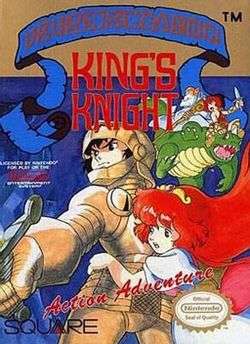King's Knight
| King's Knight | |
|---|---|
 North American NES box art | |
| Developer(s) | Workss |
| Publisher(s) |
NES Square Virtual Console Square Enix |
| Composer(s) | Nobuo Uematsu |
| Platform(s) | Nintendo Entertainment System, MSX, Virtual Console |
| Release date(s) |
NES Virtual Console
|
| Genre(s) | Scrolling shooter |
| Mode(s) | Single-player |
King's Knight (キングスナイト Kingusu Naito) is a 1986 scrolling shooter video game developed by Workss and published by Square for the Nintendo Entertainment System and MSX. The game was released in Japan on September 18, 1986, and in North America in 1989. It was later re-released for the Wii's Virtual Console in Japan on November 27, 2007 and in North America on March 24, 2008.[1]
Although featuring RPG elements and a medieval fantasy setting, King's Knight is often incorrectly credited both as an RPG and as Square's first development. It was in fact developed by Workss, and is a scrolling shooter.[2][3] It was, however, Square's first North American release under their Redmond subsidiary Squaresoft, and their first release as an independent company. King's Knight saw a second release in 1987 on the NEC PC-8801 and the Sharp X1. These versions of the game were retitled King's Knight Special and released exclusively in Japan. Nobuo Uematsu provided the musical score for King's Knight. It was Uematsu's third work of video game music composition.[4]
Gameplay
.png)
King's Knight is a vertically scrolling shooter, where the main objective is to dodge or destroy all onscreen enemies and obstacles. Various items, however, add depth to the game. As any character, the player can collect various power-ups to increase a character's level (maximum of twenty levels per character): as many as seven Jump Increases, seven Speed Increases, three Weapon Increases, and three Shield Increases. There are also Life Ups, which are collected to increase the character's life meter. To balance out the Life Ups, there are also Life Downs. Other onscreen icons can affect the stage, such as hidden cave entrances/exits and a "secret revealer," which reveals hidden stones that block progress. Finally, there are four types of elements to be collected in each level, which are vital to the completion of the last stage. These elements are simply elements A, B, C, and D.
Each stage has various power-ups, an element of each type, and a cave. Because caves in any given level always house at least one element type (not to mention various powerups), it is vital that the player finds these. Caves are always hidden and are generally found in the middle of a stage. Caves also have statues that shoot fireballs, and at the end of each cave is a dragon to fight. Once the dragon is defeated, the player can exit the cave and continue with the level.
Plot
King's Knight follows the basic storyline that many NES-era role-playing video game displayed: Princess Claire has been kidnapped in the Kingdom of Izander, and the player must train to defeat the Evil Dragon and rescue her.[5] Starring as the rescuers are the knight "Ray Jack," the wizard "Kaliva," the monster "Barusa," and the thief "Toby."
Development and release
Differences between versions
Differences were present not only in the Famicom and MSX versions of King's Knight, but in the Japanese and North American versions as well.
The Japanese (Famicom) version and the American (NES) version of King's Knight differed little, with the title screen being the only disparity. Each title screen reflected the copyright and publisher.
.gif)
The MSX version of King's Knight differed from the Famicom version in a variety of ways. The opening was modified so that prior to the intro screen, players could specify what type of controller they would like to use (either a keyboard or a joystick). The in-game dynamics were very similar, although some differences exist. In the MSX version, the flanks of the screen were "closed off," while the stage maps have moved slightly, and so some of the items appear to be out of their original locations. Finally, the MSX version may seem easier, because the characters can sustain more damage from attacks.
The developers also took advantage of technological capabilities available on the MSX. As an upgrade, the MSX port featured more sound channels than the Famicom, and as such many music tracks and sound effects were altered or improved. The MSX version also boasts a wider range of colors, updated graphics, new monster and boss designs (dragons at the end of caves, for example, were replaced with lizard-like monsters), and a new sidebar, which displayed the player's life meter, allocated power-ups, and allocated elements. Unfortunately, though, the MSX could not smoothly render vertical scrolling - unlike the Famicom - so the movement of the graphics is very "choppy" in comparison. Some of these changes are very similar to the changes that took place when Square's Final Fantasy was ported to the MSX2.
References
- ↑ "King's Knight [Virtual Console]". IGN. Retrieved 2008-07-09.
- ↑ キングスナイト | SQUARE ENIX
- ↑ Todd Ciolek (2008-03-24). "Going Virtual: March 24". Wizard Universe. Archived from the original on June 11, 2008. Retrieved 2008-07-09.
- ↑ Square Enix North America Site Staff (2005). "Uematsu's Music". Square Enix North America. Archived from the original on 2009-03-12. Retrieved 2 May 2006. External link in
|work=(help) - ↑ King's Knight (Instruction Manual). Square Soft, Inc. 1989.
External links
- Official website (Japanese)
- King's Knight (MSX) at MobyGames